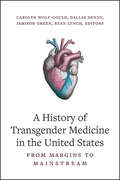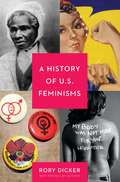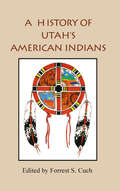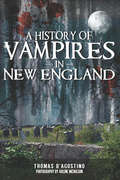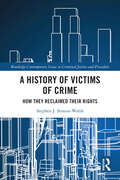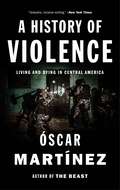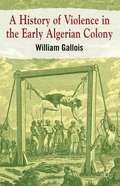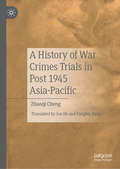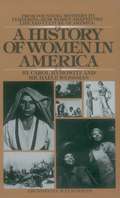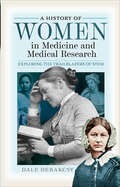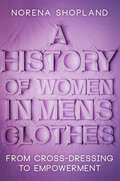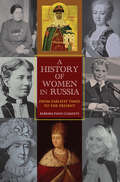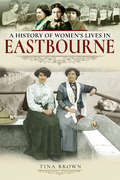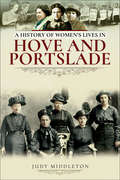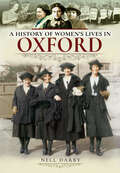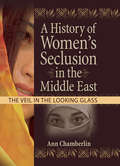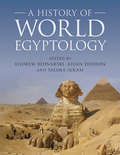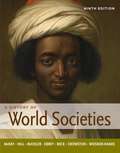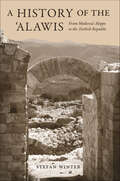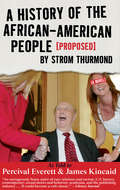- Table View
- List View
A History of Transgender Medicine in the United States: From Margins to Mainstream
by Carolyn Wolf-Gould; Dallas Denny; Jamison Green; Kyan LynchThe most comprehensive history of transgender medicine to date, as told by more than forty scholars, physicians, psychologists, and activists from trans, gender-diverse, and allied medical communities.Arriving at a critical moment in the struggle for transgender rights, A History of Transgender Medicine in the United States takes an empathic approach to an embattled subject. Sweeping in scope and deeply personal in nature, this groundbreaking volume traces the development of transgender medicine across three centuries-centering the voices of transgender individuals, debunking myths about gender-affirming care, and empowering readers to grasp the complexities of this evolving field. More than forty contributors-including patients, advocates, physicians, psychologists, and scholars-weave an illuminating, sometimes surprising narrative of collaboration and conflict between trans people and the scientists who have studied and worked with them. An indispensable guide to understanding the current tumult surrounding trans health-care access in the United States, the volume underscores a crucial message: gender diversity is not a new phenomenon but an integral part of our shared human history.
A History of Twentieth-Century American Women’s Poetry
by Linda A. KinnahanA History of Twentieth-Century American Women's Poetry explores the genealogy of modern American verse by women from the early twentieth century to the millennium. Beginning with an extensive introduction that charts important theoretical contributions to the field, this History includes wide-ranging essays that illuminate the legacy of American women poets. Organized thematically, these essays survey the multilayered verse of such diverse poets as Edna St Vincent Millay, Marianne Moore, Anne Sexton, Adrienne Rich, and Audre Lorde. Written by a host of leading scholars, this History also devotes special attention to the lasting significance of feminist literary criticism. This book is of pivotal importance to the development of women's poetry in America and will serve as an invaluable reference for specialists and students alike.
A History of U.S. Feminisms (Seal Studies)
by Rory C. DickerThe History of U.S. Feminism is an introductory text designed to be used as supplementary material for first-year women's studies students or as a brush-up text for more advanced students. Covering the first, second, and third waves of feminism, The History of U.S. Feminism provides historical context of all the major events and players since the late nineteenth century through today.The chapters cover first-wave feminism, a period of feminist activity during the nineteenth and early twentieth century which focused primarily on gaining women's suffrage; second-wave feminism, which started in the '60s and lasted through the '80s and is best understood as emphasizing the connection between the personal and the political; and third-wave feminism, which started in the early '90s and arose in part from a backlash against the movements propagated by the second wave.
A History of Un-fractured Chinese Civilization in Archaeological Interpretation
by Qingzhu LiuThis book presents an archeological interpretation of the history of Chinese civilization. Tracing back from recent history to the distant past, it explores the breadth of Chinese civilization. Using archeological remains and cultural relics as starting points and approaching the cultural dimension from material perspectives, it presents a panoramic view of China’s civilizational continuity, together with its ideological and cultural characteristics. Featuring a wealth of illustrations (including photos of cultural relics and sites, archeological surveys, etc.) and texts written in easy-to-understand language, it offers an engaging read without sacrificing academic quality. The main components of “civilization” are addressed: capital archeology, mausoleum archeology, ritual wares and architecture archeology, as well as written language. The book offers a unique resource for archeology scholars and majors, as well as general readers who are interested in Chinese archeology and history.
A History of Utah's American Indians
by Forrest S. CuchA comprehensive history of the six Native American tribes of Utah, from an Indigenous perspective.The valleys, mountains, and deserts of Utah have been home to native peoples for thousands of years. Like peoples around the word, Utah&’s native inhabitants organized themselves in family units, groups, bands, clans, and tribes. Today, six Indian tribes in Utah are recognized as official entities. They include the Northwestern Shoshone, the Goshutes, the Paiutes, the Utes, the White Mesa or Southern Utes, and the Navajos (Dineh). Each tribe has its own government. Tribe members are citizens of Utah and the United States; however, lines of distinction both within the tribes and with the greater society at large have not always been clear. Migration, interaction, war, trade, intermarriage, common threats, and other challenges have made relationships and affiliations more fluid than might be expected.In this volume, the editor and contributors endeavor to write the history of Utah&’s first residents from an Indian perspective. An introductory chapter provides an overview of Utah&’s American Indians and a concluding chapter summarizes the issues and concerns of contemporary Indians and their leaders. Chapters on each of the six tribes look at origin stories, religion, politics, education, folkways, family life, social activities, economic issues, and important events. They provide an introduction to the rich heritage of Utah&’s native peoples. This book includes chapters by David Begay, Dennis Defa, Clifford Duncan, Ronald Holt, Nancy Maryboy, Robert McPherson, Mae Parry, Gary Tom, and Mary Jane Yazzie.This book is a joint project of the Utah Division of Indian Affairs and the Utah State Historical Society. It is distributed to the book trade by Utah State University Press.
A History of Vampires in New England (Haunted America)
by Thomas D'AgostinoThe author of A Guide to Haunted New England lifts the coffin lid on the region&’s folklore and legends of the undead. New England is rich in history and mystery. Numerous sleepy little towns and farming communities distinguish the region&’s scenic tranquility. But not long ago, New Englanders lived in fear of spectral ghouls believed to rise from their graves and visit family members in the night to suck their lives away. Although the word &“vampire&” was never spoken, scores of families disinterred loved ones during the eighteenth and nineteenth centuries searching for telltale signs that one of them might be what is now referred to as the New England vampire. &“In his remarkable book . . . Thomas D&’Agostino details the longstanding belief among New Englanders that supernatural entities were responsible for the disease called consumption.&”—Crime Capsule Includes photos! Praise for A Guide to Haunted New England &“Fun, charming . . . includes not only locales with reported ghosts, but also sites with macabre (though not haunted) histories.&”—True Crime Librarian &“Anyone interested in exploring the haunted, macabre and abandoned throughout New England knows they can count on D&’Agostino to find out more about the site&’s history, past sightings and how to find them.&”—Mobile RVing
A History of Victims of Crime: How they Reclaimed their Rights (Routledge Contemporary Issues in Criminal Justice and Procedure)
by Stephen J. Strauss-WalshThis book examines the evolution of the contemporary crime victim’s procedural place within modern Western societies. Taking the history of the Irish crime victim as a case study, the work charts the place of victims within criminal justice over time. This evolves from the expansive latitude that they had during the eighteenth century, to their major relegation to witness and informer in the nineteenth, and back to a more contemporary recapturing of some of their previous centrality. The book also studies what this has meant for the position of suspects and offenders as well as the population more generally. Therefore, some analysis is devoted to examining its impact on an offender’s right to fair trial and social forms. It is held that the modern crime victim has transcended its position of marginality. This happened not only in law, but as the consequence of the victim’s new role as a key sociopolitical stakeholder. This work flags the importance of victim rights conferrals, and the social transformations that engendered such trends. In this way victim re-emergence is evidenced as being not just a legal change, but a consequence of several more recent sociocultural transformations in our societies. The book will be of interest to researchers, academics, and policy makers in criminal law, human rights law, criminology, and legal history.
A History of Violence
by Oscar Martinez Daniela Maria Ugaz John WashingtonHeartbreaking immersion into the lives of people enduring extreme violence in Central America El Salvador and Honduras have had the highest homicide rates in the world over the past ten years. Óscar Martínez, author of The Beast, which was named one of the best books of the year by the Economist and the Financial Times, shares a beautiful and immersive account of life in one of the most violent places on earth. Martinez travels to Nicaraguan fishing towns, southern Mexican brothels where Central American women are trafficked, isolated Guatemalan jungle villages and crime-ridden Salvadoran slums. With his precise and empathetic reporting, he reveals the underbelly of some of the most dangerous places in the world, going undercover to drink with narcos, accompanying police patrols, riding in trafficking boats and hiding out with a gang informer. The result is an unforgettable portrait of a region of fear, helping to explain why migrants have been fleeing the area by the millions.From the Hardcover edition.
A History of Violence in the Early Algerian Colony
by William GalloisUsing newly-discovered documentation from the French military archives, A History of Violence in the Early Algerian Colony offers a comprehensive study of the forms of violence adopted by the French Army in Africa. Its coverage ranges from detailed case studies of massacres to the question of whether a genocide took place in Algeria.
A History of War Crimes Trials in Post 1945 Asia-Pacific
by Zhaoqi ChengWritten by the Director of the Tokyo Trial Research Centre at China's Shanghai Jiao Tong University, this book provides a unique analysis of war crime trials in Asia-Pacific after World War II. It offers a comprehensive review of key events during this period, covering preparations for the Trial, examining the role of the War Crimes Commission of the United Nations as well as offering a new analysis of the trial itself. Addressing the question of conventional war crimes, crimes against humanity, crimes against peace (such as the Pearl Harbor Incident) and violations of warfare law, it follows up with a discussion of post-trial events and the fate of war criminals on trial. Additionally, it examines other Japanese war crime trials which happened in Asia, as well as considering the legacy of the Tokyo trial itself, and the foundation of a new Post-War International Order in East Asia.
A History of Women in 101 Objects
by Annabelle HirschDiscover the hidden history of women—and the world—through this visual exploration of intimate objects and the surprising, sometimes shocking stories behind them.&“I adored this book!&”—Olivia ColmanThis is a neglected history. Not a sweeping, definitive, exhaustive history of the world but something quieter, more intimate and particular: a single journey, picked out in 101 objects, through the fascinating, manifold, and too often overlooked histories of women.With engaging prose, compelling stories, and a beautiful full-page image of each object, Annabelle Hirsch&’s book contains a curated and diverse compendium of women and their things, uncovering the thoughts and feelings at the heart of women&’s daily lives. The result is an intimate and stirring alternative history of humans in the world. The objects date from prehistory to today and are assembled chronologically to show the evolution of how women were perceived by others, how they perceived themselves, how they fought for freedom. Some (like a sixteenth-century glass dildo) are objects of female pleasure, some (a thumbscrew) of female subjugation. These are artifacts of women celebrated by history and of women unfairly forgotten by it. With variety and nuance, A History of Women in 101 Objects cracks open the fissures of what we think we know in order to illuminate a much richer retelling: What do handprints on early cave paintings tell us about the role of women in hunting? How is a cell phone related to femicides? What does Kim Kardashian&’s diamond ring have to do with Elena Ferrante?Wide-ranging, subversive, witty, and superbly researched, this is a book that upends all our assumptions about, and presentations of, the past, proving that it has always been as complicated and fascinating as the women who peopled it.
A History of Women in America: From Founding Mothers to Feminists-How Women Shaped the Life and Culture of America
by Carol Hymowitz Michaele WeissmanFrom colonial to modern-day times this narrative history, incorporating first-person accounts, traces the development of women's roles in America. Against the backdrop of major historical events and movements, the authors examine the issues that changed the roles and lives of women in our society. Note: This edition does not include photographs.
A History of Women in Medicine and Medical Research: Exploring the Trailblazers of STEM
by Dale DeBakcsyIn the nineteenth century, a small but dedicated group of European and American women rose to agitate for the inclusion of women in the medical profession. It is a historic tale that we have told and retold for decades, but it is far from where the story of women as physicians and healers begins. Stretching back into deepest antiquity, we possess accounts of women who were consulted by emperors and paupers alike for their medical expertise. They were surgeons, apothecaries, midwives, university lecturers, and medical researchers in correspondence with the most learned societies of their time. And then it all came crashing down. A History of Women in Medicine and Medical Research is the story of the women who participated in that early Golden Age, and of a medical establishment closing ranks against them so effectively that, by the early Victorian era, they not only were barred from practicing medicine, but from so much as stepping into a classroom where medical topics were being discussed. It is the story of that intrepid band of reformers and pioneers who built back the women's medical profession from the ashes and constructed a thriving new community of researchers and practitioners who within a century had retaken not only the ground that had been lost, but boldly advanced to levels of fame and achievement unimaginable to any previous era. Told through in-depth accounts of the lives of the pioneers and practitioners who built and rebuilt the women's medical movement, this title dives into the lives of not only legendary figures like Florence Nightingale, Gertrude Elion, Rosalyn Yalow, and Elizabeth Blackwell, but visits women the world over whose medical contributions broke down doors and advanced the cause of women's and world health, like the revolutionary medieval physician Trota of Salerno, the pioneering eighteenth century midwife and businesswoman Madame du Coudray, the microbiological research trailblazer Mary Putnam Jacobi, and the HIV researcher and world epidemic response coordinator Francoise Barre-Sinoussi. With over 140 stories spanning three millennia of global medicine, this book shines a light on the unknown heroes, towering discoveries, tragic missteps, and profound struggles that have accompanied the Rise, Fall, and Rebirth of the women's medical profession.
A History of Women in Men's Clothes: From Cross-Dressing to Empowerment
by Norena ShoplandTraditionally, historic women have been seen as bound by social conventions, unable to travel unless accompanied and limited in their ability to do what they want when they want. But thousands of women broke those rules, put on banned clothing and traveled, worked and even lived whole lives as men. As access to novels and newspapers increased in the nineteenth century so did the number of women defying Biblical and social restrictions. They copied each other’s motives and excuses and moved into the world of men. Most were working-class women who either needed to or wanted to, break away from constricted lives; women who wanted to watch a hanging or visit a museum, to see family or escape domestic abuse, some wanted to earn a decent living when women’s wages could not keep a family. The reasons were myriad. Some were quickly arrested and put on display in court, hoping to deter other women from such shameful behavior, but many more got away with it. For the first time, A History of Women in Men’s Clothes looks at those thousands of individuals who broke conventions in the only way they could, by disguising themselves either for a brief moment or a whole life. Daring and bold, this is the story of the women who defied social convention to live their lives as they chose, from simply wanting more independence to move and live freely, to transgender and homosexual women cross-dressing to express themselves, this is women’s fight to wear trousers.
A History of Women in Russia: From Earliest Times to the Present
by Barbara Evans ClementsA survey of the key political, economic, social, and cultural developments in Russian women’s history from 900 to 2010, and their impact on the nation.Synthesizing several decades of scholarship by historians East and West, Barbara Evans Clements traces the major developments in the history of women in Russia and their impact on the history of the nation. Sketching lived experiences across the centuries, she demonstrates the key roles that women played in shaping Russia’s political, economic, social, and cultural development for over a millennium. The story Clements tells is one of hardship and endurance, but also one of achievement by women who, for example, promoted the conversion to Christianity, governed estates, created great art, rebelled against the government, established charities, built the tanks that rolled into Berlin in 1945, and flew the planes that strafed the retreating Wehrmacht. This daunting and complex history is presented in an engaging survey that integrates this scholarship into the field of Russian and post-Soviet history.“The product of a lifetime of engagement by one of the preeminent authorities on the history of Russian women, the book reflects the author’s deep expertise in primary sources as well as her familiarity with the secondary literature.” —Choi Chatterjee, California State University Los Angeles“A significant achievement in scholarship on Russian women and gender. . . . Among this text’s many strengths are its lucidity, readability, and engaging synthesis of a large number of both primary and secondary sources. . . . Its erudite contextualization of the history of Russian women within a larger European framework ensures its interest for and accessibility to a wide readership, especially those outside of the Slavic field.” —Slavic and East European Journal“Clements’s writing is engaging, clear, and jargon free, making this book easily accessible to a general audience. . . . Highly recommended.” —Choice“This daunting and complex history is presented in an engaging survey that integrates this scholarship into the field of Russian and post-Soviet history.” —Journal of Turkish Weekly
A History of Women's Lives in Eastbourne
by Tina BrownA historian examines the developments in women&’s lives over a period from 1850 to 1950 in the famous southeastern England seaside town. The southeast coastal town of Eastbourne is probably best known today as a popular holiday resort frequented by the retired generation. It has long, golden beaches and a gentile pace of life and, from that point of view, little has really changed from the mid-1850s to today. However, for the women of the town and their advancements and achievements, a significant period was between 1850 and 1950, when changes in medicine, education, family life, and the right to vote played an important part in their lives. The First and Second World Wars also brought about their own changes and challenges. A History of Women&’s Lives in Eastbourne delves deep into these historical subjects and more.
A History of Women's Lives in Hove and Portslade
by Judy MiddletonThis book looks at the lives of the women from Hove and Portslade, ranging from artists, musicians, writers, performers, reformers, pioneering doctors and business-women to those employed in factories, shops, laundries and as domestic servants, not forgetting, of course, women's contribution to war-work in both of the world wars. There are facts about their ordinary lives, birth, marriage and death; their education; their leisure activities from guns to cycling, the gym, swimming and horse riding.It is also appropriate to reflect on the Votes for Women movement, when brave souls battled against prejudice to achieve the franchise. Not all women felt the same, of course, and although there was apathy at first, Brighton and Hove was home to an early group of suffragists who were passionate in their beliefs but disliked the violence embraced by the suffragettes.If you ever thought women deserved more than being a mere footnote in history, then this is the book for you.
A History of Women's Lives in Oxford
by Nell DarbyUnderneath the dreaming spires of Oxford&’s world-famous university, generations of women have lived their lives, fighting for the right to study there, and for a role within the city&’s educational, political and social spheres. Although a few of these women&’s names have been recorded for posterity, they have been largely because of their association with worthy or famous men; in this book, though, their own lives are detailed, along with those who have been largely omitted from history. Women&’s lives have always been less recorded than those of men; where a woman helped her husband with his business, this help may not have been formally recorded in the census returns, and the details of jobs recorded there might not reflect the full-scale of women&’s work and responsibilities. So here, learn about the variety of work women undertook; their education, their social lives, and their attempts to carve out a valuable role for themselves. Learn too of the problems they faced in living their lives: poverty, prison, suicide, or even murder. This is no pretty picture of Oxford life designed for tourist brochures; instead, it aims to take a snapshot of the varied experiences of the city&’s female population over the course of a century.
A History of Women's Political Thought in Europe, 1700-1800
by Karen GreenDuring the eighteenth century, elite women participated in the philosophical, scientific, and political controversies that resulted in the overthrow of monarchy, the re-conceptualisation of marriage, and the emergence of modern, democratic institutions. In this comprehensive study, Karen Green outlines and discusses the ideas and arguments of these women, exploring the development of their distinctive and contrasting political positions, and their engagement with the works of political thinkers such as Hobbes, Locke, Mandeville and Rousseau. Her exploration ranges across Europe from England through France, Italy, and Germany to Russia, and discusses thinkers including Mary Astell, Emilie Du Châtelet, Luisa Gottsched and Elisabetta Caminer Turra. Her study demonstrates the depth of women's contributions to eighteenth-century political debates, recovering their historical significance and deepening our understanding of this period in intellectual history. It will provide an essential resource for readers in political philosophy, political theory, intellectual history, and women's studies.
A History of Women's Seclusion in the Middle East: The Veil in the Looking Glass
by J Dianne Garner Linn PrentisLearn how the seclusion of women can be used as a feminist defense against exploitation-and as an empowering forceInternationally acclaimed author Ann Chamberlin&’s book, A History of Women&’s Seclusion in the Middle East: The Veil in the Looking Glass is a critical interdisciplinary examination of the practice of seclusion of women throughout the Middle East from its beginnings. This challenging exploration discusses the reasons that seclusion may not be as oppressive as is presently generally accepted, and, in fact, may be an empowering force for women in both the West and East. Readers are taken on a controversial, belief-bending journey deep into the surprising origins and diverse aspects of female seclusion to find solid evidence of its surprising use as a defense against monolithic cultural exploitation. The author uses her extensive knowledge of Middle Eastern culture, language, and even archeology to provide a convincing assertion challenging the Western view that seclusion was and is a result of women&’s oppression. A History of Women&’s Seclusion in the Middle East goes beyond standard feminist rhetoric to put forth shocking notions on the real reasons behind women&’s seclusion and how it has been used to counteract cultural exploitation. The book reviews written evidence, domestic and sacred architecture, evolution, biology, the clan, the environment for seclusion, trade, capital and land, slavery, honor, and various other aspects in a powerful feminist argument that seclusion is actually a valuable empowering force of protection from the influence of today&’s society. The text includes thirty black and white figures with useful descriptions to illustrate and enhance reader understanding of concepts.A History of Women&’s Seclusion in the Middle East discusses at length: prehistoric evidence of seclusion the sense of honor in the Middle East a balanced look at the Islamic religion the true nature of the harem the reasons for the oppression by the Taliban the positive aspects of &’veiling&’ seclusion as a defense against capitalist exploitation and other challenging perspectives!A History of Women&’s Seclusion in the Middle East is thought-provoking, insightful reading for all interested in women&’s history, feminism, and the history and culture of the Middle East.
A History of World Egyptology
by Salima Ikram Aidan Dodson Andrew BednarskiA History of Egyptology is a ground-breaking reference work that traces the study of ancient Egypt. Spanning 150 years and global in purview, it enlarges our understanding of how and why people have looked, and continue to look, into humankind's distant past through the lens of the enduring allure of ancient Egypt. Written by an international team of scholars, the volume investigates how territories around the world have engaged with and have been inspired by Egyptology, and how that engagement has evolved over time. Each chapter presents a specific territory from an institutional and national perspective, while examining a range of transnational links as well. The volume thus touches on multiple strands of scholarship, embracing not only Egyptology, but also social history, the history of science and reception studies. It will appeal to amateurs and professionals alike.
A History of World Societies (Combined Ninth Edition)
by Roger B. Beck John Buckler John P. Mckay Bennett D. Hill Patricia Buckley Ebrey Clare Haru Crowston Merry E. Wiesner-HanksA History of World Societies introduces students to the global past through social history and the stories and voices of the people who lived it. Now published by Bedford/St. Martin's, and informed by the latest scholarship, the book has been thoroughly revised with students in mind to meet the needs of the evolving course. Proven to work in the classroom, the book's regional and comparative approach helps students understand the connections of global history while providing a manageable organization. With more global connections and comparisons, more documents, special features and activities that teach historical analysis, and an entirely new look, the ninth edition is the most teachable and accessible edition yet. Test drive a chapter today. Find out how. Download samples of Chapter 12 and Chapter 16. Or, read the preface.
A History of the 'Alawis: From Medieval Aleppo to the Turkish Republic
by Stefan WinterThe ‘Alawis, or Alawites, are a prominent religious minority in northern Syria, Lebanon, and southern Turkey, best known today for enjoying disproportionate political power in war-torn Syria. In this book, Stefan Winter offers a complete history of the community, from the birth of the ‘Alawi (Nusayri) sect in the tenth century to just after World War I, the establishment of the French mandate over Syria, and the early years of the Turkish republic. Winter draws on a wealth of Ottoman archival records and other sources to show that the ‘Alawis were not historically persecuted as is often claimed, but rather were a fundamental part of Syrian and Turkish provincial society.Winter argues that far from being excluded on the basis of their religion, the ‘Alawis were in fact fully integrated into the provincial administrative order. Profiting from the economic development of the coastal highlands, particularly in the Ottoman period, they fostered a new class of local notables and tribal leaders, participated in the modernizing educational, political, and military reforms of the nineteenth century, and expanded their area of settlement beyond its traditional mountain borders to emerge from centuries of Sunni imperial rule as a bona fide sectarian community. Using an impressive array of primary materials spanning nearly ten centuries, A History of the ‘Alawis provides a crucial new narrative about the development of ‘Alawi society.
A History of the African-American People (Proposed) by Strom Thurmond, as told to Percival Everett & James Kincaid (A Novel): A Novel
by James Kincaid Percival EverettPraise for Percival Everett:"If Percival Everett isn't already a household name, it's because people are more interested in politics than truth."--Madison Smartt Bell, author of The Washington Square Ensemble"Everett's talent is multifaceted, sparked by a satiric brilliance that could place him alongside Richard Wright and Ralph Ellison . . ."--Publishers Weekly"I think Percival Everett is a genius. I've been a fan since his first novel. He continues to amaze me with each novel--as if he likes making 90-degree turns to see what's around the corner, and then over the edge . . . He's a brilliant writer and so damn smart I envy him."--Terry McMillan, author of MamaA fictitious and satirical chronicle of South Carolina Senator Strom Thurmond's desire to pen a history of African-Americans--his and his aides' belief being that he has done as much, or more, than any American to shape that history. An epistolary novel, The History follows the letters of loose cannon Congressional office workers, insane interns at a large New York publishing house and disturbed publishing executives, along with homicidal rival editors, kindly family friends, and an aspiring author named Septic. Strom Thurmond appears charming and open, mad and sure of his place in American history.Percival Everett is the author of 15 works of fiction, among them Glyph, Watershed and Frenzy. His most recent novel, Erasure, won the Hurston/Wright Legacy Award and did little to earn him friends.James Kincaid is an English professor at the University of Southern California and has written seven books in literary theory and cultural studies. These books and Kincaid himself have gradually lost their moorings in the academic world, so there was nothing left for him to do but to adopt the guise of fiction writer. Writing about madness comes easy to him.
A History of the Arab Peoples
by Albert HouraniFrom the 7th century, the rise of Islam, thru Muslim societies, the Ottoman Age, the European empires, nation-states to the current Arab unity and disunity.
